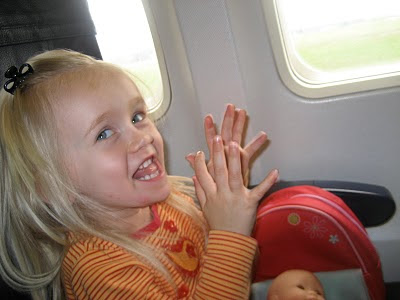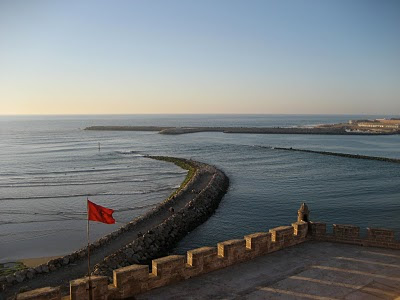Tuesday last we walked along Rabat's Mohammed V (every Moroccan city has one!), took our ease in the shade of a café across from the parliament building, and bought dried apricots at the Marché Central just before heading into the Medina for lunch. Hazel and I were visiting friends from the States who are in Rabat for a couple months (both of them Arabists, in one sense or another), a good excuse to take one last trip before leaving Morocco.
Rabat is the capital; you feel it immediately -- it's a
city, where Marrakech is (at its worst) a dust-bound yet sparkly watering hole for tourists. Rabat (to me) is a cross between Fez and Essaouira. Fez because of the bustling size, the official government buildings, the boulevards (and a
felt European presence), Essaouira because of the Atlantic -- the fresh air despite the heat, the white walls, the bright light of by-the-sea.

Where Rabat's intellectuals are said to chill, the café at Hotel Balima...

...which sits across Mohammed V from the Moroccan parliament.

Our friends speak Arabic (one of them also Darija), so Ken asked a passerby about this building that looked as if it might be right at home in San Francisco's posh Pacific Heights. The guy said, "Oh, it's a building of some sort" -- or something about as helpful. Without a guidebook in hand I don't know for sure-- but the architecture of this section of town looked very 1920s. Which makes sense. It was chosen by the presiding French mucky-muck, General Lyautey, as the seat of the French Protectorate presence in Morocco, circa 1912.

Hazel, ever happy in the grass.

And then telling me what she'd like from the spice and nut shop.

Heading out of the Medina after lunch (really good roast chicken and french fries, watermelon for dessert and not too sweet mint tea), we passed this offering of water -- a tall terra cotta urn sitting in a shallow plastic tub of water, covered with a metal plate on which sat a metal cup for drinking -- right in the middle of what's also called Avenue Mohammed V, even in the Medina. I've never seen this before.

Across from the parliament a group was gathered, protesting -- a loyal opposition, Moroccan flags fluttering all around them. Ken again played translator (read the sign) and said the group was Berber, asking for rights of some sort, asking to be recognized. That's the gist of it anyway.

Next morning Hazel and I set off to the Chellah, site of both an ancient Roman city, Sala Colonia, and the Merenid necropolis of Chellah (14th century). The fortified site is just across a flower-filled meadow from the old city walls of Rabat. The original settlers of these grassy hills above the Oued Bou Regreg were Phoenicians; the Romans arrived in AD 40 (with thanks to Lonely Planet). City walls at left, crenelated tower of the Chellah just visible at right.

Now we are inside the walls, looking up before heading down the hill.

Hazel pauses on the way down, stork nest-topped minaret of the Merenid mosque and medrasa in the distance.

In the trees all around us a chorus of storks (and egrets I think too) yackety-yacked. The Berber term for stork is "lak-lak" -- an onomatopoeic name for sure.

Facing a span of perhaps 1300 years of architecture, Roman ruins in the foreground.

Just the bottom half of what looks like a lovely draped figure. I wish I could provide an informed caption, but this is it -- half a Roman, baking in the everlasting sun.

Another section of Latin text I need someone to translate -- Katherine!? Kate?! Sam?! Ellie?!

Now into the mosque complex (Roman ruins to the left in this image), almost through the arch of the mosque's entry. Archaeologists say that these walls in all likelihood were built on top of existing Roman walls.

Hazel pauses on the threshold.

Looking back the way we came in, entrance from the inside.

And up to the roof of the sky, inside what was once the mosque.

Ken speculates this was the
mihrab (niche which faces Mecca) from which the imam would have spoken.

Margaret says the learned would have gathered scholars around them beneath these pillars -- as the mosque included a medrasa, or school for Koranic study (with residential students).

And here is what they're looking at: more storks on nests.

Hazel inspects the ground beneath her feet.

Mausoleum of the Black Sultan, Abou el-Hassan, last Merenid ruler to be buried here, 1351. --

Detail of the
zellij tilework surrounding the mausoleum.

And a view from the mausoleum's backside.

What originally had been the ablutions pool for the mosque is now a home to eels -- women (are said to) offer cooked eggs to the eels as a cure for infertility, or just in hopes. Potent combination of the Islamic and the pre-Islamic.

Said eels -- one anyway.

Five small saints' tombs dot the hillside above the eel pool, tended by an elderly gentlemen who also feeds the cats. He told Ken that in the old days people would come to pay homage to the saints -- the old people have died, no one comes anymore.

One last look back as we head up the hill -- another stork wings by.

View of the entrance (as we walk away) -- scaffolding piled up for a jazz concert to be held on the Chellah's grounds -- devotees flock here now for other reasons.




















































